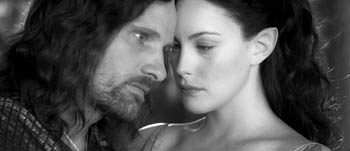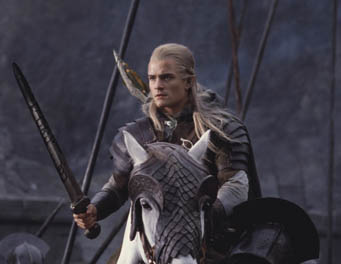![[Metroactive Movies]](/gifs/movies468.gif)
[ Movies Index | Show Times | Santa Cruz | Metroactive Home | Archives ]
Precious Times
Gollum is the center of attention in 'The Two Towers'
By Richard von Busack
THE CLOUDS lowering all through The Lord of the Rings: The Fellowship of the Ring finally burst into full storm in The Lord of the Rings: The Two Towers. Essentially, it's 1942 in Middle-earth. The severed parts of the Fellowship are spread out in confusion. Our heroes are lost in the woods and on the plains: Sam (Sean Astin) and Frodo (Elijah Wood) at first stray, then are captured; Pippin (Billy Boyd) and Merry (Dominic Monaghan) escape and are captured again. The return of Gandalf is no surprise, especially since George Lucas swiped it root and branch for the resurrection of Obi-Wan in Star Wars. But Ian McKellen has comparatively little to do in The Two Towers; he performs one faith healing, and away he goes.
The film focuses on a new kingdom, that of the horsemen of Rohan, who live in a Celtic-Maori village in the hills. A sick king, Théoden (Bernard Hill), is poisoned by a treacherous counselor, Wormtongue (Brad Dourif). Chased from their homes by Sauron's army, refugees head for sanctuary in the fortress at Helm's Deep. Cornered by the hills, a handful of humans staves off what looks like several million demon warriors forged in the crucibles of Saruman (Christopher Lee). The human city of Gondor is reduced to broken masonry, and prevaricating tree people weather the war, pondering whether to strike.
There is one character who reflects the rampant confusion and dislocation, for The Two Towers is truly Gollum's story. The crippled, maddened wretch serves as a living warning of what will happen if the Ring is not destroyed.
It was predicted that one day a synthesized actor would compete on its own terms with flesh and blood thespians. It happens in The Two Towers. Andy Serkis' voice and mannerisms are the source for Gollum. But even as an animated character, this poor schizophrenic creature gives the most devastating supporting performance of the year. In Gollum's bulging eyes, bald head and lethal obsequiousness, in his fury and self-laceration, we see echoes of Peter Lorre at his best.
As counterpoint to Gollum's anguish, the film boasts the raw purpose and sensuality of Viggo Mortensen's Aragorn. Here is the most visually commanding lone rider since the glory days of the cowboy movies. There's really no way to make a Western in 2002 without sourness, debunking or campiness. The universal appeal of The Lord of the Rings series, however, is partially due to a lack of irony and camp, so Aragorn has a scene that goes straight to the essence of the Western: he lies on the bank of a peaceful river, apparently dead, and his horse, kneeling to roll his wounded master onto his back, nudges him to semiconsciousness.
Aragorn has a tentative love for a new woman, Éowyn (Miranda Otto), the princess of Rohan, but he's held back remembering an old lover--in tender flashbacks of Liv Tyler, who was never this good before she got elf ears.
There is, unfortunately, something unforgivable in The Two Towers, and I'm not talking about the hurriedly animated assault on Saruman's tower. Éowyn shows how she handles a sword, and Aragorn heartens her with dialogue so gallant it stings. But later, when her people are warring in the most incredible castle siege scene ever filmed, where is she? Answer: in the keep with the women and children! You can't tell me she's too frail; Éowyn is rather larger than a certain dwarf, though Brian Rhys-Davis' Gimli once again provides some refreshing comedy in a very serious film.
Peter Jackson's epic features a few showstoppers. Gandalf vs. the Balrog is like St. Michael chasing Satan out of heaven--a battle fought while plummeting. Another shocking moment arrives in an abrupt, brutal skirmish in a green meadow between the heroes and a horde of ultra-Orcs who ride charging hyenas the size of SUVs. All work as spectacle, but we get computer-animated spectacle of this kind all the time.
This second piece of the trilogy resounds not just because of childhood memories of reading about hobbits but because of everything Tolkien scooped up into his trilogy: myths and fairy tales and Shakespeare. When Aragorn rallies the defenders at Helm's Deep before the first wave of assault, when the longbow arrows rise up in a wave in the night and the rain, passages from Henry V come to the mind unbidden. And that's how well The Two Towers conveys the panic and excitement of battle.
Some may complain that the film presents a nest of subplots without one compelling plot. Yet this spectacle justifies itself with its intelligence. Jackson shows us the anguish of the refugees; we see the young men who are big enough to fight being torn away from their weeping mothers and clapped into armor. Beneath its surface excitement, The Two Towers broods over everything that war drives out--everything that even peace itself will never be able to bring back.
[ Santa Cruz | Metroactive Central | Archives ]
Copyright © Metro Publishing Inc. Maintained by Boulevards New Media.
![]()

So, How's that lobotomy working out for you? It's the blank stare that shows he cares in 'The Two Towers.'

Santa's in trouble now! Poor working conditions lead the elves to revolt in 'The Two Towers.'
The Lord Of The Rings: The Two Towers: (PG-13; 179 min.), directed by Peter Jackson, written by Frances Walsh, Philippa Boyens, Stephen Sinclair and Jackson, based on the novel by J.R.R. Tolkien, photographed by Andrew Lesnie and starring Elijah Wood, Viggo Mortensen and Ian McKellen, plays countywide.
From the December 18-24, 2002 issue of Metro Santa Cruz.